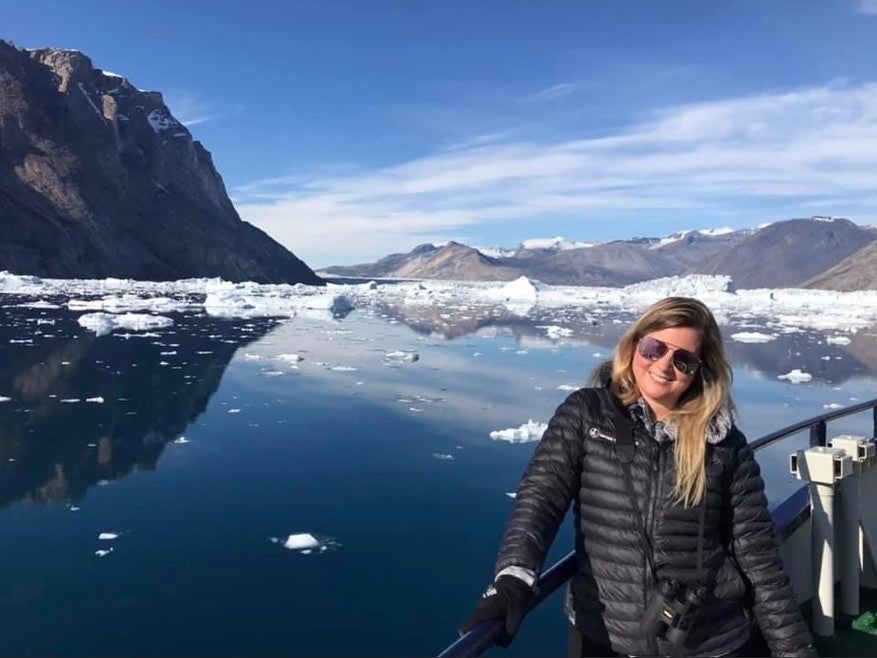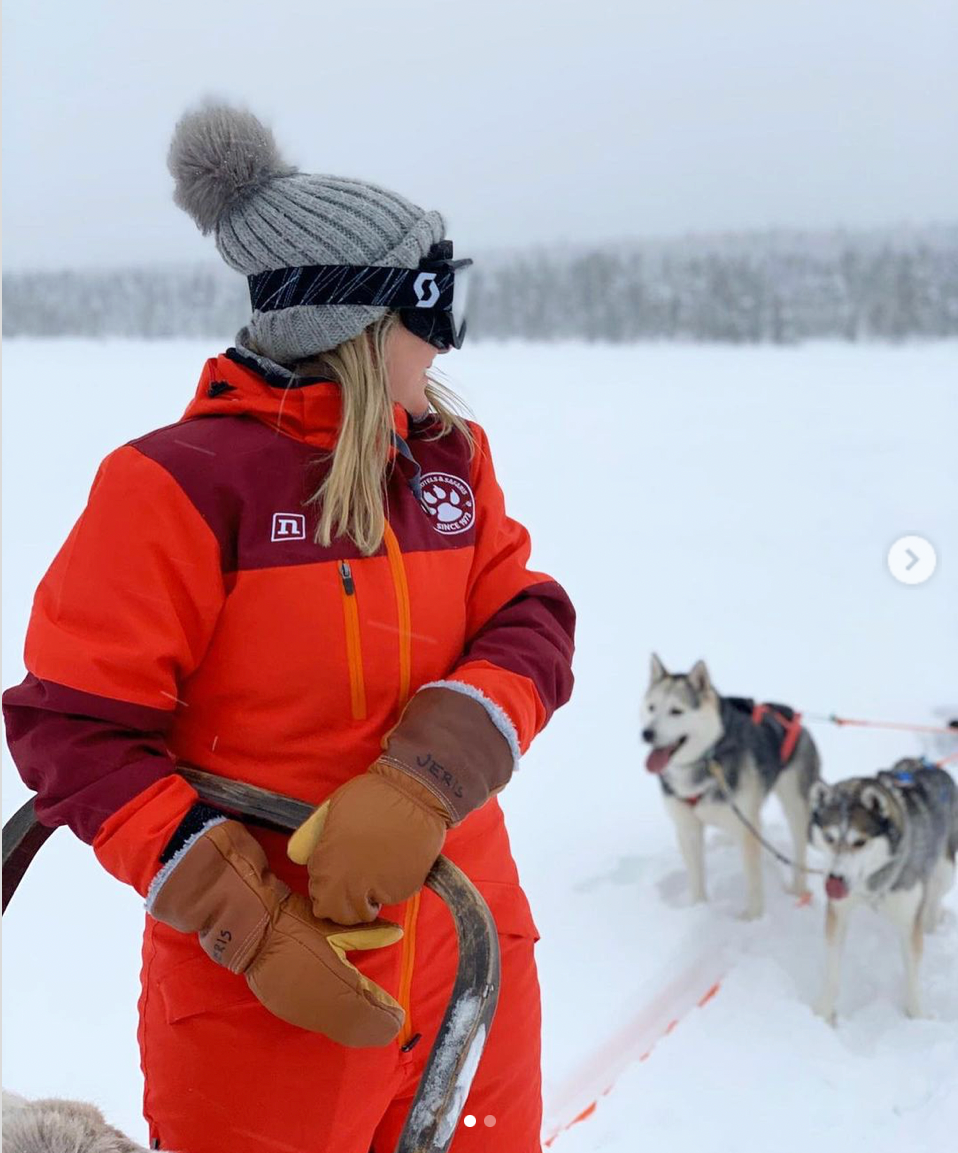‘Arctic weather? You haven’t really experienced it until you have been in its frozen beauty’
As we face some of the coldest weather of the year, travel writer and author Lizzie Pook explains why the Arctic blast feels very different when you are in Greenland or beyond. Beguiled by the icy Far North, she explains why she kept returning to its magnificent beauty – and how it became the evocative backdrop for her new book, ‘Maude Horton’s Glorious Revenge’

It began with the faintest glimpse of fur, sighted through rain-splattered binoculars one cold, pink morning. I stood on the ice-rimed deck of the ship, fingers numb from the merciless wind, and raised the lenses to look again. There was no mistaking it: peeking out from the top of a snowdrift on a shingly beach, hundreds of miles from the nearest settlement, was the fur of a polar bear. The first I had ever seen.
That trip to the east coast of Greenland, through the tendrilous, otherworldly fjord systems of Scoresbysund, changed my life. We were a small ship of just 13 passengers, without contact with any other humans for the best part of two weeks. It was just us and inky waters roiling with humpbacks, icebergs passing like cathedrals of geode crystals and shaggy muskoxen dotting the mountainsides. It was a place where time stood still, where we were able to explore fjords that hadn’t seen visitors since Inuit hunters paddled their canoes through hundreds of years ago. And as that polar bear took to its huge paws and raised a coal-black nose to the air, I knew a new love affair was about to begin. The Arctic had me in its grip.
This wasn’t my first time in the Arctic, but it is the moment my interest tipped over into obsession. After that, I travelled north whenever I could, taking on any commission that meant I could spend more time in this beguiling part of the world. In the very north of Iceland’s Troll Peninsula, kissing the outer edges of the Arctic circle, I hiked mountains and watched the silky green northern lights perform their dance. From the deck of an electric ship in Norway’s Skjervoy, I marvelled at hunting orca and mighty sea eagles dive-bombing fat bait balls for their dinner. An epic trip to sub-Arctic Canada and the remote town of Churchill, on the banks of Hudson Bay, gifted me the chance to helicopter over polar bear habitat, gawping at land striated like Vienetta, and dozens of bears making their way across the ice.

The Arctic blew my mind time and time again, giving me something truly magical – an escape, a suspension of reality, a place so bombastically beautiful you can believe that anything is possible.
Then, a pandemic slammed into us. My world, like so many others, shrunk to something very small. Trapped inside with time stretching ahead of me, I started researching 19th-century accounts of Arctic exploration. In particular, I turned to tales of the remote, ice-choked Northwest Passage – the much elusive trade route through the archipelago of islands at the top of Canada, linking the Atlantic and Pacific oceans.
I became engrossed in stories of British Navy captain Sir John Franklin and others faltering in their hubristic attempts to “force” the passage. Tales of ships floundering in the ice. Men sent mad by the ravages of the Arctic wastelands. Wonder. Cannibalism. I inhaled books like The North Water by Ian McGuire and The Terror by Dan Simmons. I interviewed those who live on the shores of Baffin Bay, walking alongside stalking polar bears, faces gilded by the northern lights, sighting the rare, swirled tusks of narwhals poking through cracks in the ice floes.
I interviewed those who live on the shores of Baffin Bay, walking alongside stalking polar bears, faces gilded by the northern lights, sighting the rare, swirled tusks of narwhals poking through cracks in the ice floes
When lockdown restrictions eased, I trawled polar and maritime museums for glimpses of what life was like aboard these Victorian expedition ships. I walked the decks of similar vessels, imagining what it might be like to climb the rigging and see an endless stretch of ice, buttresses and ravines, storming out like a snow queen’s lair around you.
One day, I was handed something very special by a family friend. It was the diary of George Brown, a young sailor who, in 1848, had travelled out to the Northwest Passage on the HMS Investigator. I couldn’t believe I was holding such treasure. The pages were filled with quotidian tales of life aboard an Arctic ship – the crew setting traps for Arctic foxes as snow swirled around them, bellies grumbling from meagre rations when the ice hemmed them in – juxtaposed with moments of wonder and awe: the magnificent aurora borealis, wily tricks of the light that made it look like ghost ships were incoming on the horizon.

I decided, at this point, to put my obsession on the page, and began writing a novel, Maude Horton’s Glorious Revenge. I wrote about a young, ambitious woman, Constance Horton, who escapes her life in London and disguises herself as a cabin boy to board The Makepeace, a ship bound for the Northwest Passage. When tragedy befalls Constance, her sister Maude, back home in London, is told her death is nothing more than an accident. But Maude knows when she is being lied to, and sets out to uncover the truth. Exploring the Arctic through Constance’s diaries kept me going while the rest of the world around me crumbled. I’d lost my travel writing work overnight, I was living in my mum’s attic bedroom and had been diagnosed with a debilitating chronic illness to boot. But as long as I had that ship, as long as I had Arctic skies and narwhals and wheeling gannets, I could keep going.
Like so many sailors who tried to make the route but were beaten back by mauling ice, scurvy or the ravages of the weather, the Northwest Passage remains elusive to me; my metaphorical white whale
A few months ago, a rare chance came for me to make it out to the Northwest Passage. It felt seismic, like something I had been working towards for years. And as I waited in an airport hotel for the call to travel and board the ship, I was sure I was on the precipice of something life-changing. But, as with so many things in life, the universe had other plans. The call never came; our ship was stranded in hostile weather and no planes were allowed to fly into the Passage.
Like so many sailors who tried to make the route but were beaten back by mauling ice, scurvy or the ravages of the weather, the Northwest Passage remains elusive to me; my metaphorical white whale. And that’s OK. Because we are not the ones in control here – the Arctic is mightier than us all. Plus, I have a secret weapon. I know that in order to get out there, in order to feel the frigid wind on my face and look up to see those mottled pink skies, soaring seabirds and mirrored clouds, all I need to do is pick up a pen and start writing. What a privilege that is.
Maude Horton’s Glorious Revenge (Picador, £14.99) is published on 1 February
Join our commenting forum
Join thought-provoking conversations, follow other Independent readers and see their replies
Comments
Bookmark popover
Removed from bookmarks